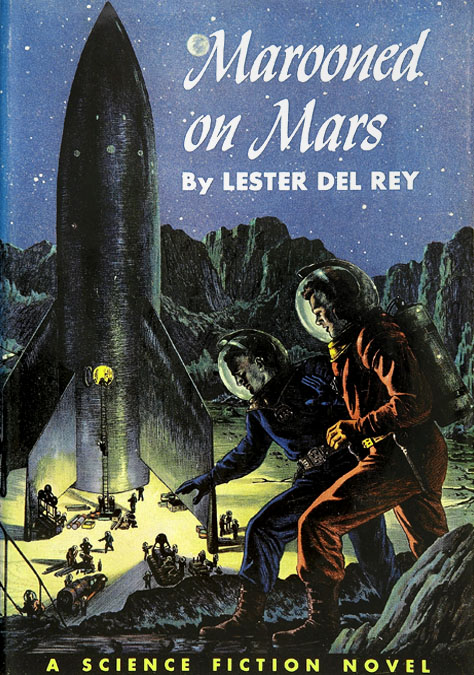
Download Right Over
HERE
HERE
Part of The Winston Science Fiction series Marooned on Mars is a quick, easy, and solid read. Readily available in the public domain this one makes a great introduction to the Red Planet.
According to wiki: Marooned on Mars is a 1952 juvenile science fiction novel by Lester Del Rey. Illustrations in the first edition are by Alex Schomburg. It was originally commissioned as one of the first five volumes in the Winston Science Fiction series published by the John C. Winston company.
According to wiki: Marooned on Mars is a 1952 juvenile science fiction novel by Lester Del Rey. Illustrations in the first edition are by Alex Schomburg. It was originally commissioned as one of the first five volumes in the Winston Science Fiction series published by the John C. Winston company.
Much of the material here is solid old school science fiction Sol system action.
The plot could have been something right out of Captain Video from the 50's and the plot has a great retro future feel to it.
The plot could have been something right out of Captain Video from the 50's and the plot has a great retro future feel to it.
Chuck Svenson, a seventeen-year-old living on the Moon, is chosen to be one of six crew members of the first spaceship to travel to Mars. His juvenile status keeps him from being allowed to take the position, once his age is discovered. He boards as a stowaway, and is accepted by the other crew upon discovery. The Mars landing is a disaster, damaging the ship. While attempting to repair the ship, the crew encounter aliens, who abduct Chuck without harming him. The crew learns that the aliens are friendly, and want the crew to be able to return to the Moon.
Using Marooned On Mars For Your Old School
Space Opera Campaigns.

I've been looking at Marooned On Mars for the last couple of days and this book makes a great zero level adventure for a game like X plorers or even Star Frontiers with its retrofuture look and feel. The science is very outmoded in some respects but it allows the DM to vary the contents with easy.
When it comes to a game like Stars Without Number, Maroon offers an interesting opportunity. With a bit of work the DM could use this as a zero level adventure for the party and fill in a bit of back history for PC's. Further, the plot could be transported to a Mars like world where the plot elements could be used as a first contact point adventure.
The PC's could be used as fodder for a follow up expedition to find out details on the crew of Chuck Svenson's space craft. The first contact details and follow up could unlock further mission details as the DM desires.
Much of the mission details of Marooned, are bits and pieces that I've used in my own Post Apocalyptic Mars campaign several times now. Dropping hints and clues to the various missions that have gone on since nineteen fifty two.
The Del Rey Legacy and the Winston Science Fiction Series

To say that Del Rey was an interesting character in the annals of science fiction is an understatement.
According to wiki:
Del Rey first started publishing stories in pulp magazines in the late 1930s, at the dawn of the so-called Golden Age of Science Fiction. He was associated with the most prestigious science fiction magazine of the era, Astounding Science Fiction, from the time its editor John W. Campbell published his first short story in the April 1938 issue: "The Faithful", already under the name Lester del Rey. By the end of 1939 he had also placed stories in Weird Tales (edited by Farnsworth Wright) and Unknown (Campbell),[2] which featured more horror and more fantasy respectively. In the 1950s, del Rey was one of the main authors writing science fiction for adolescents (along with Robert A. Heinlein and Andre Norton). During this time some of his fiction was published under the name "Erik van Lhin"
Much of the influence of Del Rey was felt though out the Seventies and you couldn't walk into a book store without stumbling into at least twenty to thirty titles with the imprint. Once again Wiki :
Much of the influence of Del Rey was felt though out the Seventies and you couldn't walk into a book store without stumbling into at least twenty to thirty titles with the imprint. Once again Wiki :
Del Rey was most successful editing with his fourth wife, Judy-Lynn del Rey, at Ballantine Books (as a Random House property, post-Ballantine) where they established the fantasy and science fiction imprint Del Rey Books in 1977.[8] After science fiction gained respectability and began to be taught in classrooms, del Rey stated that academics interested in the genre should "get out of my Ghetto."[9][10] Del Rey stated that "to develop science fiction had to remove itself from the usual critics who viewed it from the perspective of [the] mainstream, and who judged its worth largely on its mainstream values. As part of that mainstream, it would never have had the freedom to make the choices it did – many of them quite possibly wrong, but necessary for its development."[11] For a number of years in the 1970s, Del Rey, himself, helmed the review column for Analog Science Fiction and Fact entitled The Reference Library.
Del Rey was a member of an all-male literary banqueting club, the Trap Door Spiders, which served as the basis of Isaac Asimov's fictional group of mystery solvers, the Black Widowers. Del Rey was the model for "Emmanuel Rubin"
No comments:
Post a Comment
Note: Only a member of this blog may post a comment.